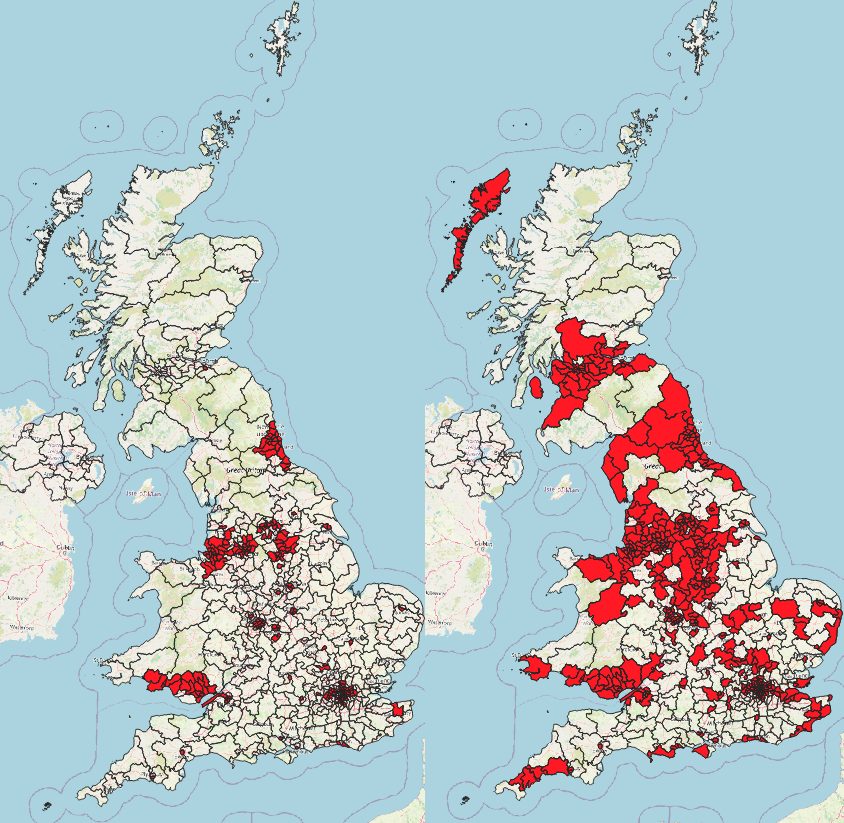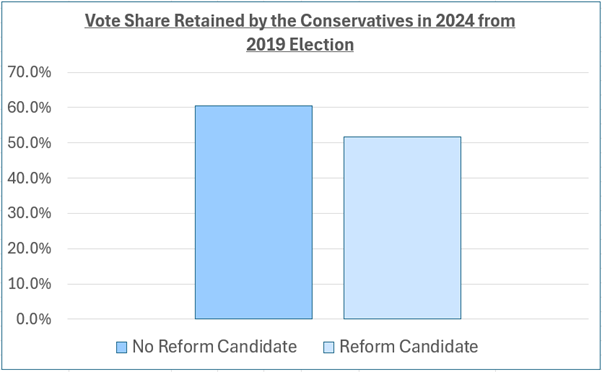The Labour party has just won its best set of results in terms of seat share since 2001 and the Conservatives have suffered their worst defeat since time immemorial. It would be easy to accept this as being the sole takeaway of the election just gone, but that would mean disregarding the major stories and election trends that were set and broken in what could be described as the weirdest set of election results in modern British history.
In this blog, we shed light on data and insights that seek to answer some of these key questions.
(Note that in all comparisons made between the election in 2024 and prior elections, we use the implied results according to the new boundaries.)
Before looking at how marginal the UK's seats have become, the first thing to note about this election compared with 2019 is that the turnout in every constituency was down. The turnout was down the most in Liverpool Riverside (down 20pc) and down the least in Lagan Valley (down 0.2pc). This is compared to a national turnout drop of 7.4pc.
In terms of marginality of seats, there were 23 constituencies in 2019 that had majorities of under 1,000 votes. Contrast this with 51 seats whose margin of victory for the winning candidate fell below 1,000 votes in 2024 and you can straight away see how more volatile the political landscape has become. The average majority in the recent election was just over 7,000, which is notably lower then the 12,500 votes in the 2019 election.
| Majority Up to | 2019 | 2024 |
|---|---|---|
| 1,000 | 23 | 51 |
| 2,000 | 45 | 100 |
| 3,000 | 85 | 137 |
Number of constituencies won by small margins. Table covers all UK seats.
There are 223 marginal seats in the Commons with a majority of less than 10pc of the votes cast. That is more marginal seats than in any election in the last seventy years. There are 104 Labour MPs nursing marginal constituencies, who may become a little more nervous if and when Labour's honeymoon period wears off. If Labour were to lose all those marginals in the future, then their overall majority would vanish.
Such is the shallowness of Labour's victory in many seats that only a national swing of 4.5% from Labour to the Conservatives is required for there to be a hung parliament, assuming the smaller parties stay fixed. A swing of 7.5% and 10.5% are required for the Conservatives to be the largest party and have an overall majority respectively. For context, the national swing to the Conservatives in 2019 from Labour under Boris Johnson was 4.5% and this was considered a huge feat for the former prime minister. Achieving a 10% swing for the future Conservative leader after one term of a Labour government would be a huge undertaking and would require something out of the ordinary to happen.
| LAB to CON Swing | CON | LAB | LIB | Reform | Green | SNP/ Plaid | LAB Seats | CON Seats |
|---|---|---|---|---|---|---|---|---|
| 1% | 25% | 34% | 13% | 15% | 7% | 3% | 390 | 144 |
| 2% | 26% | 33% | 13% | 15% | 7% | 3% | 373 | 160 |
| 3% | 27% | 32% | 13% | 15% | 7% | 3% | 356 | 179 |
| 4% | 28% | 31% | 13% | 15% | 7% | 3% | 339 | 195 |
| 5% | 29% | 30% | 13% | 15% | 7% | 3% | 319 | 219 |
| 6% | 30% | 29% | 13% | 15% | 7% | 3% | 295 | 247 |
| 7% | 31% | 28% | 13% | 15% | 7% | 3% | 279 | 264 |
| 8% | 32% | 27% | 13% | 15% | 7% | 3% | 263 | 281 |
| 9% | 33% | 26% | 13% | 15% | 7% | 3% | 246 | 299 |
| 10% | 34% | 25% | 13% | 15% | 7% | 3% | 230 | 315 |
| 11% | 35% | 24% | 13% | 15% | 7% | 3% | 208 | 338 |
Table shows the impact of the Labour and Conservative seat tally for various LAB-CON swing scenarios, keeping all other parties' vote shares fixed.
As for the breadth of Labour's support, this can be illustrated by looking at the surface area of seats they cover in Great Britain. After the 2019 election, Labour's parliamentary representation was mostly confined to the cities, suburbs and south Wales valleys. By 2024, Labour's expanse now stretches far and wide from the Lake District to Cornwall, from coast to coast and from the Outer Hebrides to the Isle of Wight. Beforehand, Labour constituencies accounted for less than 5% of the land area of Great Britain. This figure now stands at 31% and in terms of land area represented, Labour has gone from third place to first.| Party | GB Area Covered 2019 | GB Area Covered 2024 |
|---|---|---|
| LAB | 4.7% | 31.2% |
| CON | 66.9% | 30.9% |
| LIB | 1.4% | 22.9% |
| SNP | 24.8% | 9.8% |
| Plaid | 2.2% | 3.4% |
| Green | 0.0% | 1.1% |
| Reform | 0.0% | 0.7% |
| MIN | 0.0% | 0.1% |
Amount of surface area covered by all parties of Great Britain
This emphasises the gains that Labour have made in rural and coastal areas in England, which have traditionally been won by the Conservatives or the Liberal Democrats. Their gains in Scotland beyond the central belt of Glasgow and Edinburgh are also noteworthy.

Seats Labour held before and after 2024 general election.
The vast majority of people who voted for Reform UK voted to leave the European Union in 2016 and a huge proportion of those went on to support Boris Johnson in the 2019 general election. While electoral behaviour is complicated and there are undoubtedly some Reform UK voters who would never vote Conservative, it is worth nothing that, in 181 seats, Reform UK got more votes than the difference between the losing Conservative candidate and their first placed opponent.
If all Reform votes had gone to the Conservatives (with all other party vote tallies staying the same), then the result would be a hung parliament with the Conservatives out in front on 302 seats compared with Labour's 268. Half of all Reform votes going the Conservatives' way would give them a seat tally of 210, a near doubling of their present tally.
| Party | 2024 Result | Hypothetical Result if Half Reform Vote CON | Hypothetical Result if All Reform Vote CON |
|---|---|---|---|
| LAB | 412 | 342 | 268 |
| CON | 121 | 210 | 302 |
| LIB | 72 | 61 | 46 |
| NAT | 13 | 10 | 9 |
| Reform | 5 | 0 | 0 |
| MIN | 5 | 5 | 5 |
| Green | 4 | 4 | 2 |
Seat tally according to different scenarios of votes from Reform to the Conservatives as per 2024 election result.
Looking at GB seats, the Conservatives retained a 52% share of their 2019 vote in constituencies where Reform fielded a candidate (609 seats). In the 23 seats where Reform failed to field a candidate (such as Epping Forest and Cheltenham), the Conservatives retained 60% of their vote, which is suggestive of the fact that had Reform not stood, the Conservatives would have fared better.
It is worth noting however that in the 23 seats where Reform failed to stand a candidate, not one seat had the Conservatives holding on by a narrow margin. There were three seats our of the 23 where the Conservatives came first, but the wining Conservative candidate had a majority of more than 10% in all three of those seats.

Conservative vote share retained in Reform and non-Reform seats
The author Norah Bentinck once wrote that "politics and religion mixed is the headiest cocktail ever invented". Which might, paradoxically, be a sobering thought.
What was quite apparent in the election just gone was the extent to which pockets of strength of one faith or another pointed to the performance of certain parties, presenting a phenomenon we have never really seen at a recent general election before.
In seats where there is a Muslim population greater than 25%, the Labour vote decreased by 25pc (additively), leading to the victory of some four pro-Gaza independents.
In strong Hindu seats, where Hindus make up over 20% of the population, there was a net swing to the Conservatives from Labour of 6%. Notably, the only Conservative gain of the night happened to be in Leicester East which is also the only seat to have Hinduism as its largest religion. Harrow East was the only seat in the country for the Conservatives to win an outright majority of all votes cast and this seat is the third most Hindu seat in the country.
Some positive news for Labour on the religious front is that in seats with a Jewish population of more than 15%, the Labour vote was up 6pc on average with a swing to them from the Conservatives of 10pc. There are four seats in the UK with a Jewish population of over 15% – Bury South, Finchley and Golders Green, Hendon, and Hertsmere. Three out of four of these seats were Labour gains from the Conservatives, with Hertsmere being the only one to stay blue.